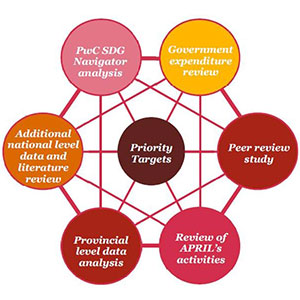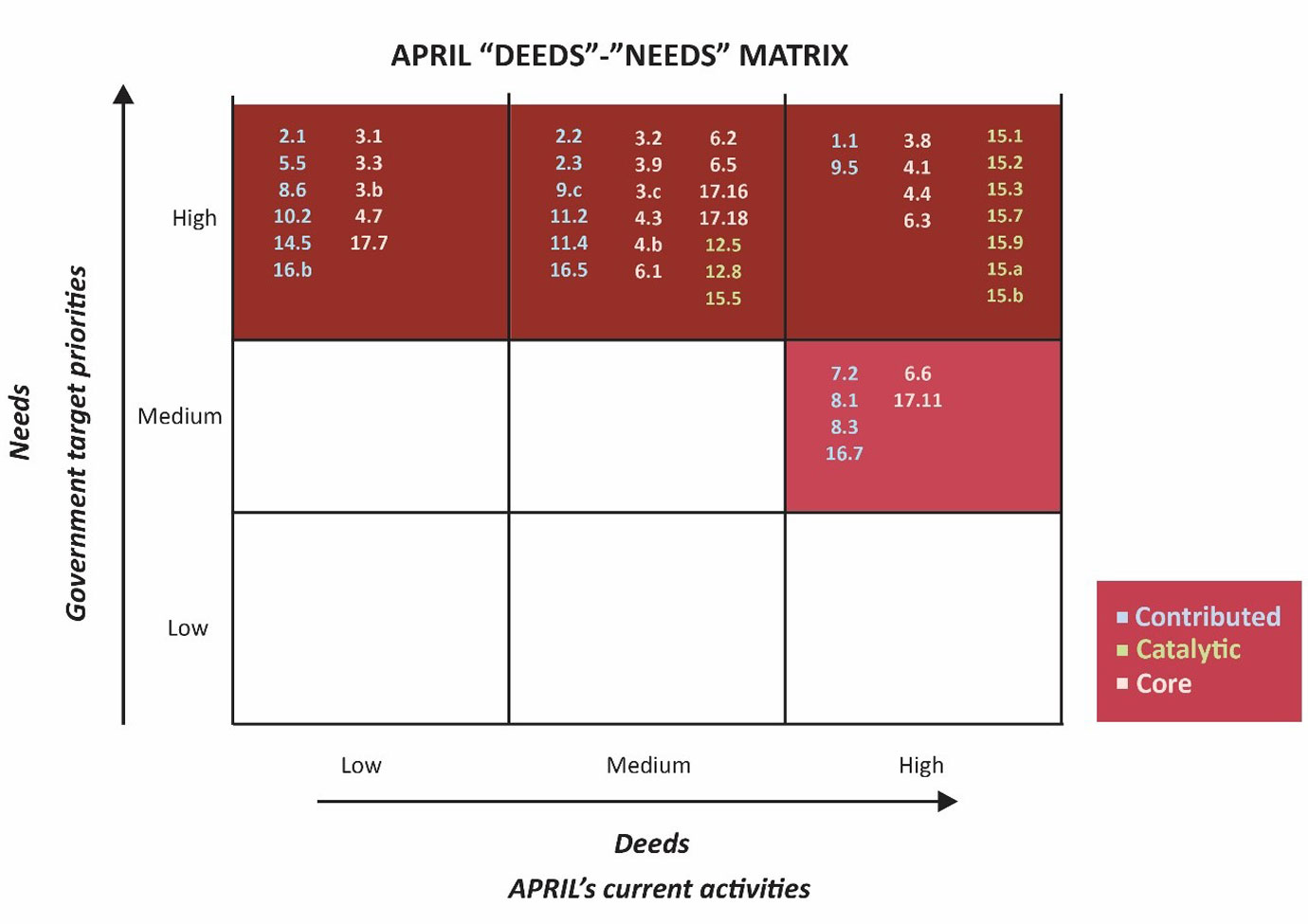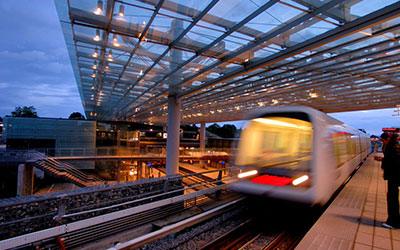Thorough SDG prioritization to maximize impact
APRIL GroupAWARENESS & UNDERSTANDING OF THE SDGs
APRIL as part of Royal Golden Eagle (RGE) has long been committed to regional social and economic development in the Province of Riau, in Sumatra, Indonesia, guided by the need to first generate benefits for the community, country, climate and customers, and lastly for the company. Internally, we refer to this as the 5Cs principle, which is woven into our operations through the RGE Sustainability Framework and APRIL’s Sustainable Forest Management Policy (SFMP 2.0) and is complemented by a number of socially-, economically- and environmentally focused programs and initiatives.
Prior to the adoption of the SDGs, we had gained useful knowledge about our socio-economic impact in the Riau Province by working with the University of Indonesia. We recognized that the SDGs provided the opportunity to complement this work and to assess and inform our sustainability approach more holistically with regard to our strategy, measurement, and alignment of our actions and investments with local, national and international priorities.
Based on our experience and understanding of the SDGs, their impact can be most meaningful and transformative for the lives of our many and various stakeholders in Riau Province if our operations, sustainability commitments and community initiatives are strategically focused on where the need is greatest.
To help us in the process of informing our corporate decision making, our sustainability strategy and programs by using the SDGs as a guiding framework, we have been working with PwC Singapore over the course of last year (2018). This effort also aimed at identifying areas beyond the company’s core focus, where we can have a catalytic impact and support the achievement of the SDGs in Indonesia at national, provincial and community level.
THE PROCESS OF DEFINING PRIORITIES
We worked to identify our SDG priority goals and targets using bottom-up and top-down approaches and a combination of different data sources as well as inputs from various stakeholders. This process included: a review of company activities, the use of PwC’s own SDG Navigator, national level data analysis supported by a literature review, provincial level data analysis, a review of government expenditures, and a peer review study.
APRIL’s alignment with the SDGs:
- Review of APRIL’s activities: We carried out a qualitative assessment of APRIL’s current operations and initiatives to understand the current level of alignment with the SDG targets. This helped reflect the relevance and significance of the targets for APRIL, taking into account the potential scale of impact APRIL could have on a particular target. The evaluation approach included employee questionnaires, interviews with the management and key external stakeholders, such as the Independent Peat Expert Working Group (IPEWG), and the external Stakeholder Advisory Committee (SAC).
Need assessment in Indonesia and Riau:
- PwC’s SDG Navigator uses publicly available information to rank and score the performance of every country on the official SDG indicators, which are disclosed on the UN Global SDG Indicators Database. The Navigator ranking is based solely on the performance on the official SDG indicators. Data on these official indicators is continually being worked on by UN and international statisticians. At the time of the assessment, data was available for 90 indicators that were included in the Navigator.
- National level data and literature: Where the UN Global SDG Indicators Database lacked data, we consulted a range of alternative sources, such as SDSN’s SDG Index, the World Bank or other UN agencies (e.g. ILO, FAO, UNICEF, UNESCO). National level data across different countries were analysed similarly to the UN SDG Indicators Database to evaluate the performance of Indonesia relative to other countries on metrics relevant to each SDG target.
- Provincial level data analysis: Provincial level data informed the overall analysis and adjustments were made as needed. The most significant change as a result of incorporating provincial data was seen in relation to SDG 6 (Clean water and sanitation) and SDG 8 (Work and economic growth). Targets 8.6 (Proportion of youth not in employment, education or training) and 6.1 (Universal and equitable access to safe and affordable drinking water) were seen to perform worse after adjustment.
Other considerations:
- Peer review: Through this peer analysis we sought to better understand how sector peers are engaging with the SDGs and what areas are of particular relevance and importance to the industry as a whole. Eleven companies were selected based on industry relevance, robustness of their sustainability reports, extent of engagement with SDGs and SDG disclosure, and geographic coverage. The results of the mapping exercise were used to find the goals and targets with the greatest activity across the close peers. Among the most prioritized were goals 3, 6, 8, 12, 13 and 15, the least prioritized were goals 1, 2, 10, 11, 14, 16. Peer and public spending priorities were not considered as part of the categorisation, but was used as an additional lens by APRIL.
- Government expenditure review: We reviewed the Riau Government Regional Action Plan to identify the spending commitments towards projects addressing specific SDG targets over the next three years. The Riau province SDG spending plan included data covering 230 projects, totaling to about US$ 400 million. While this investment plan covered projects aligned with all 17 SDGs, the greatest allocation was on SDG 3 (Good health and well-being) and SDG 4 (Quality education). SDG 16 (Peace and justice) and SDG 8 (Decent work and economic growth) had the greatest number of distinct projects focused on them. The fewest discrete projects were to address SDG 7 (Affordable and clean energy), although these are allocated a significant proportion of spending. The least prioritized goals, with the lowest allocation of resources in terms of spending with less than 0.7% of total spending combined were goals 5, 9, 12, 13 and 15. Based on this information, APRIL is supporting the Government in achieving the Goals from the bottom up and in a manner that is aligned with APRIL’s specific conditions and capabilities, i.e. operations, size, location, etc. (focus on Catalytic Goals 3 and 4 below).
SETTING TARGETS & INDICATORS
Upon the completion of this analysis and in an effort to break down the level of priority, we categorized the identified goals and targets into Core, Catalytic and Contributed areas and mapped them on a Deeds (APRIL’s capability and level of activity) versus Needs (needs and priorities at national and provincial level) matrix (see below):
- Core: Goals and targets that we consider central to the nature of our business and operations;
- Catalytic: Goals and targets that we consider to be a major need outside of our direct operations, particularly in surrounding communities;
- Contributed: Goals and targets where we have historically made strong contributions in Riau Province (SDGs 1, 2, 8, 9 and 10).
In total, seven Goals have been prioritized across two tiers:
Core Goals represent the strongest alignment with the company’s operations and our sustainability commitments and where we can continue to have the greatest impact locally, nationally and internationally:
- SDG 12: Responsible Production and Consumption
- SDG 13: Climate Action
- SDG 15: Life on Land
Catalytic Goals represent where we can have an exponential impact on surrounding communities:
- SDG 3: Good Health and Wellbeing
- SDG 4: Quality Education
- SDG 6: Clean Water and Sanitation
- SDG 17: Partnerships for the Goals
APRIL will measure the direct impact of their activities for identified Core and Catalytic Goals. On the longer term, activities focusing on these SDGs will also have an indirect impact on other SDGs, including the Contributed Goals. For example, Goal 4 (Quality Education) will eventually contribute to Goal 1 (No Poverty).
DISCLOSURE AND NEXT STEPS
The publication of PwC Singapore’s report in March 2019 outlines the assessment process in great detail and completed the first phase of the project.
The next phase of the project involves developing a framework to measure APRIL’s baseline impact on selected SDG targets under these priority goals. The final stage of the project will be a report on impact measurement, which will help guide future investments and strategies.
PwC Singapore’s report on phase one has been an important milestone in the way we communicate and share progress with our stakeholders. We have also used a range of internal and external communications platforms, including our Sustainability Report and on APRIL Dialog and national and global forums and events to transparently share our progress, experiences and insights.
We have gained several insights from this process including:
- An in-depth understanding of the SDGs and their interdependencies;
- An appreciation of the need to focus our contribution in areas where we can have the most profound impact;
- A deeper understanding of the important role business plays in supporting the achievement of national and global goals;
- A reinforced view on the importance of partnership and collaboration across sectors, and the power of the SDGs as an enabler.
When we did the prioritization analysis, we specifically looked at target levels. Targets for SDG 13 are mainly focused on governmental actions, and as such, there is no direct link to our core operations and activities. However, we believe that what we do in other SDGs (i.e. Goal 12 and 15) has a direct impact on Goal 13. Additionally, Goal 13 is a high priority among peer companies. As a result, we also identified it as one of our core priorities.





